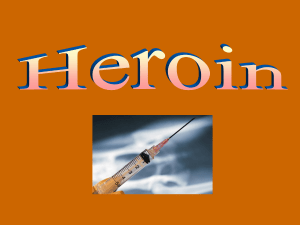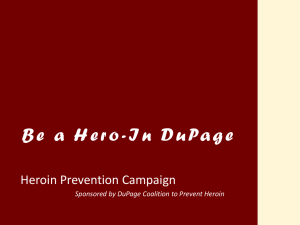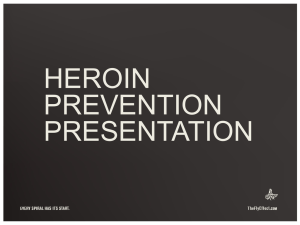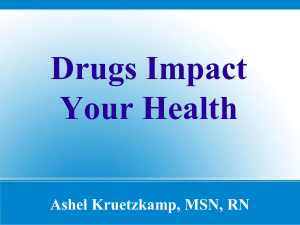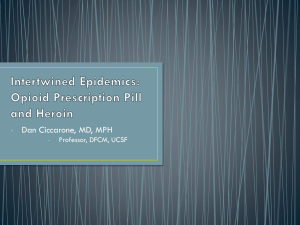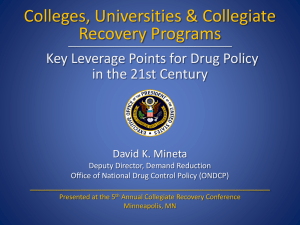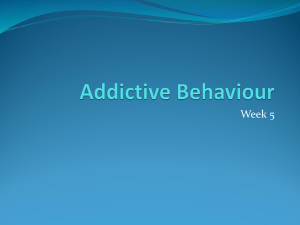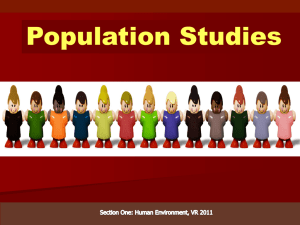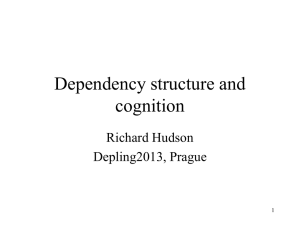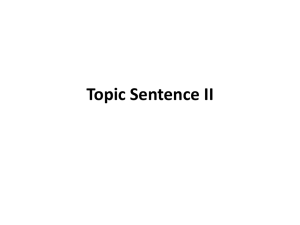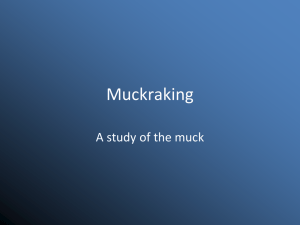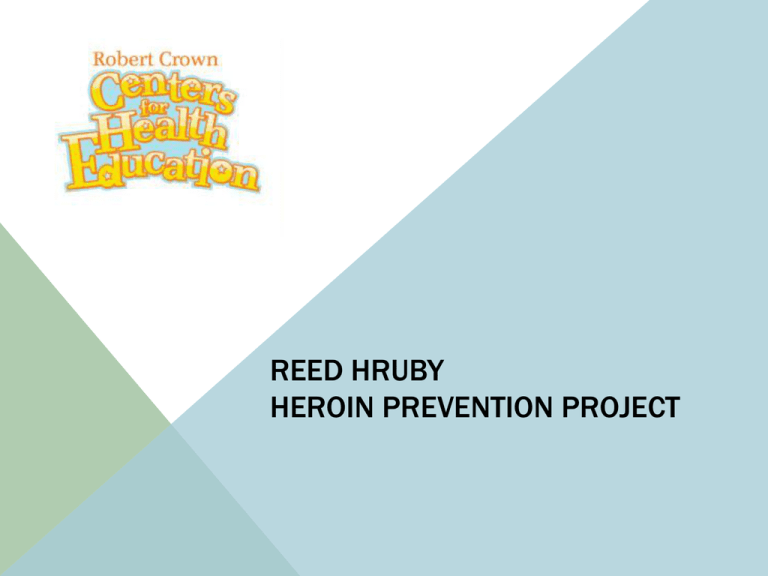
REED HRUBY
HEROIN PREVENTION PROJECT
ROBERT CROWN CENTER HISTORY
• 1958- Opened our doors as Hinsdale
Health Museum
• Currently have offices in Hinsdale, North
Lawndale, Aurora
• Serve more than 80,000 students annually
• Mission: Keep kids happy, healthy, safe
• Major topic areas: puberty and sex education,
drug use prevention, obesity prevention
• New audiences
TODAY’S OBJECTIVES
• Increase knowledge of heroin use trends in
the Chicago suburbs
• Share key findings from Robert Crown
sponsored primary research conducted by
Illinois Consortium on Drug Policy
• Provide suggestions for actions to reverse
trend
REED HRUBY HEROIN PREVENTION PROJECT
• Background of our drug program renovations
• Hruby proposal
• Partnership with Reed Hruby Memorial
Foundation, Robert Crown Center, IL Consortium
on Drug Policy
• Timeline
• Accomplishments so far
• Research included literature review, interviews,
focus groups, life-mapping
NATIONAL INDICATORS OF
GROWING HEROIN USE
• Initiations to heroin have increased 80% since 2002, from
around 100,000 in 2002 to over 180,000 in 2009.
• 34,000 youths initiate to heroin in a given year (ages 12-17).
• On any given day 3,753 youth (12 to 17year olds) use heroin.
TREATMENT AND HOSPITAL DISCHARGES
DEMONSTRATE GROWTH AMONG YOUNG
USERS
• Across the United States, treatment admissions for heroin from
1996 to 2006 increased 56 percent among teens and 58 percent
among young adults.
• The majority of youth aged 12 to 17 entering public treatment for
heroin across the nation was White (76%), followed by Latinos (16
%), and African Americans (2%).
• In Illinois, nearly 70% of youth under age 18 admitted to public
treatment were White and 85% of those aged 15 to 19 discharged
from the hospital were White.
WHERE DOES IT COME FROM?
• Majority comes from Mexico (high purity, low
price)
• Teens purchase it in open-air markets on
Chicago’s West Side (Austin blvd. off the
Eisenhower)
• Cheap, 10 dollars per bag
• Highly pure…kids don’t have to inject it to get
high
SUBURBAN HEROIN NOT CONFINED TO
CHICAGO AREA
Atlanta, St. Louis, Cincinnati, New York City, Kansas
City, Wichita, Boston, Philadelphia, Milwaukee, Denver,
Los Angeles, Salt Lake City, Charlotte, Baltimore,
Seattle, San Jose, Detroit, and Chicago have all
reported increasing and alarming use among younger
people in the suburbs.
WHAT IS HEROIN?
• Heroin is in a class of drugs known as depressants.
Alcohol and Xanax are examples of other types of
depressants.
• Depressants are drugs that temporarily slow down
your central nervous system.
• Heroin is an opioid. All opioids are depressants.
Other opioids include things like prescription pain
medications (Vicodin or OxyContin).
UNDERSTANDING HEROIN USE, ADDICTION,
AND DEPENDENCY
• Only nicotine ranks higher in dependency profile.
• Of those who are offered heroin, about 20% will try it
• Of those who try it, 25% will proceed to dependency.
• Physical dependency, withdrawal symptoms develop
rapidly
• Tolerance develops rapidly (leading to increased use)
• Causes more harm to users than other “hard drugs”
HOW DOES HEROIN CAUSE ADDICTION?
• Heroin molecules rapidly cross the blood-brain barrier
• Heroin causes neurons in the brain to release a flood
of dopamine
• Dopamine makes the user feel good
• The user’s brain creates links between feeling good
and heroin use
• Repeated use reinforces these links
• When drug is gone, chemical imbalance in brain
causes physical withdrawal symptoms
HEROIN RESPONDENTS: CHARACTERISTICS
• All from the suburbs including Cook, DuPage and Will
Counties.
• Half were male, half female.
• Youngest was 22, oldest was 31.
• Wide range of socio-economic backgrounds, peer group
participation and experiences.
CO-OCCURRING DISORDERS
AND SELF MEDICATION
The majority of the sample self reported co-occurring disorders
or symptoms:
• Depression
• Anxiety Disorders
• ADHD
• Bipolar Disorder (this was the least common)
The majority of the interviewees indicated that heroin use was
a form of self-medication for depression or other problems:
I was in my own world, in my own area, doing my own
thing….And it [heroin] would make me not be sad.
SENSATION SEEKING
More than two-thirds of the sample exhibited sensation seeking behaviors, which
include risk-taking (e.g. skydiving); disinhibition; boredom susceptibility; and
adventurousness:
I found going to the west side exciting. It was a thrill. The chance was that you
could get caught, but the reward was that you got your dope. I am a thrill-seeker.
I bungee-jumped when I was 12. I used to steal small things just to do it. My
parents would describe me that way – as a thrill seeker.
LOW DRUG KNOWLEDGE AMONG
PARTICIPANTS
We had a D.A.R.E. program, but they spoke to us mostly about
violence and gangs. And that was all in elementary school.
And in high school it was just sex education. No drug
education then. I didn’t know it [heroin] was a downer like it
was. I thought it was like marijuana. I thought that the people
that got addicted – that it was all in their head. I just saw
heroin as another drug. I thought maybe it wasn’t true that it
was so bad. I thought maybe people did more than they could
handle.
NO UNDERSTANDING OF DEPENDENCY
Being around people that were doing it, if you don’t see
anything bad happening, then it seems OK. But that was in
the beginning. I expected it all to be like in the beginning
when I was not getting sick. All those things that were
supposed to happen were not happening then, so I thought
it was fine. And I kept using.
If I knew about withdrawal, I would not have done it. If I
knew, I would never have used. If they could show people
this, what it is like— I think people might not use.
PEER GROUP
Two patterns emerged
1. Individual leaves peer group or seeks out people using drugs.
2. Heroin comes to the group and spreads.
When I turned 20, a lot of my close friends from that group were starting to do
heroin. And then my other friends in the group started using. And then I was
around all them and thought it was OK to try.
After dependence, peer group changed to include other heroin
users.
INITIATION: MODE OF ADMINISTRATION
All interviewees sniffed or snorted heroin:
When I was at [college] then I heard about it. And this person snorted it. And he said
“you don’t get addicted this way” since you are snorting it and not injecting it.
I didn’t think it would be bad sniffing it. I thought, oh, when you sniff it, then it’s ok.
If you are at a party and someone opens a pack and dips a key into the powder and
then puts it under your nose and says sniff, that’s not so scary. That’s how we did it.
PILL USE → HEROIN
About one third of interviewees were misusing or
dependent on opioid pills before transitioning to
heroin.
I didn’t use heroin first – I broke my foot and I was out of
pain in like 2 weeks, but he [the doctor] kept me on Vicodin
for 8 months. I kept calling for refills and he kept giving
them to me. I didn’t know it was addicting. I figured it was
safe because it was from a doctor and he kept giving it to
me.
Pill use softened perception of heroin use
I remember thinking that I was scared to try it because it
was heroin, but then I remember thinking that it was the
same as Oxys, so it was OK.
DISCOVERING DEPENDENCY
Dependency was generally pointed out by another person
I really thought I had the flu. I said “lately I’ve been feeling weird like I am sick”
and my friend V flat out told me “that’s withdrawal.” I don’t remember what I felt.
I know it wasn’t good. I was surprised. I didn’t know what addicted meant. I
didn’t understand why people would get sick or how or why they would have to
use all day.
FOCUS GROUP METHODS
To participate:
Had to have used at least one illicit substance in high school AND had to attend a
suburban high school.
Recruited through a variety of means including:
•
Posted in Triblocal, Craigslist
•
Posted on Facebook college and high school networks
•
Posted fliers throughout the suburbs at public locations
•
Handed out fliers over the summer at public beaches, malls and other areas
where young people congregate.
Participants names were not recorded, used disposable phone and gmail address to
ensure confidentiality.
DRUG EDUCATION
•
Participants believed drug education was not comprehensive
• Focused primarily on tobacco, alcohol and marijuana
• Did not provide information or discussion on heroin or other “hard drugs”
•
Programs “lumped drugs together,” making it difficult to understand the effects of
specific drugs on the person
•
Programs did not clearly explain addiction, dependency or withdrawal
•
Programs did not help students understand the path from experimenting to addiction
•
“Just don’t do it” is not a reason
PARTICIPANT KNOWLEDGE
• High disapproval of heroin, low disapproval of opioid pills
• Did not understand the link between the two (heroin and
pills)
• Did not understand differences between “dependency” and
"addiction”
• Understood that there was a link between mental health
and drug use, but not how the two were linked
ADDRESSING KNOWLEDGE GAPS
• Participants believed parents did not have the
knowledge or communication skills to talk to them
about drugs
• Did not know where to go to find a source of
accurate, quality information about drugs
MAJOR TRENDS
• Heroin use is a growing problem in Chicago
suburbs
• Because it is highly addictive, this trend won’t
fix itself!
• What can we do?
PARENTS
• Talk to your kids!!!
• Monitor for behavior changes (dropping out of
activities, change of friends, grades drop, etc.)
• Link between mental health disorders and heroin
use
• Look for signs (watery eyes, runny nose, appears
sleepy and distant, frequent excuses, valuables
missing, high mileage on car)
• Push school board to support drug prevention
SCHOOLS
• Research-proven effective education at every grade
level
• Authentic messages from authentic messengers
• Parent resources
• Staff development training
• School wide system for early intervention
MEDICAL COMMUNITY
• Educate patients about potential danger of pain
medication
• Closely monitor pain medication, and prescribe the
minimum amount necessary
TODAY’S OBJECTIVES
• Increase knowledge of heroin use trends in
the Chicago suburbs
• Share key findings from Robert Crown
sponsored primary research conducted by
Illinois Consortium on Drug Policy
• Provide suggestions for actions to reverse
trend

